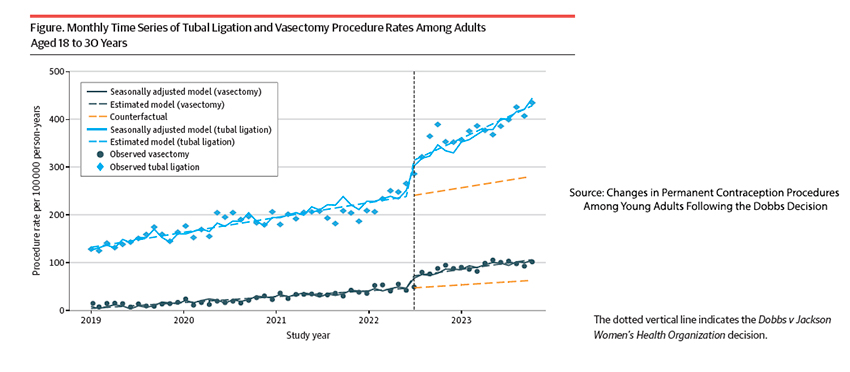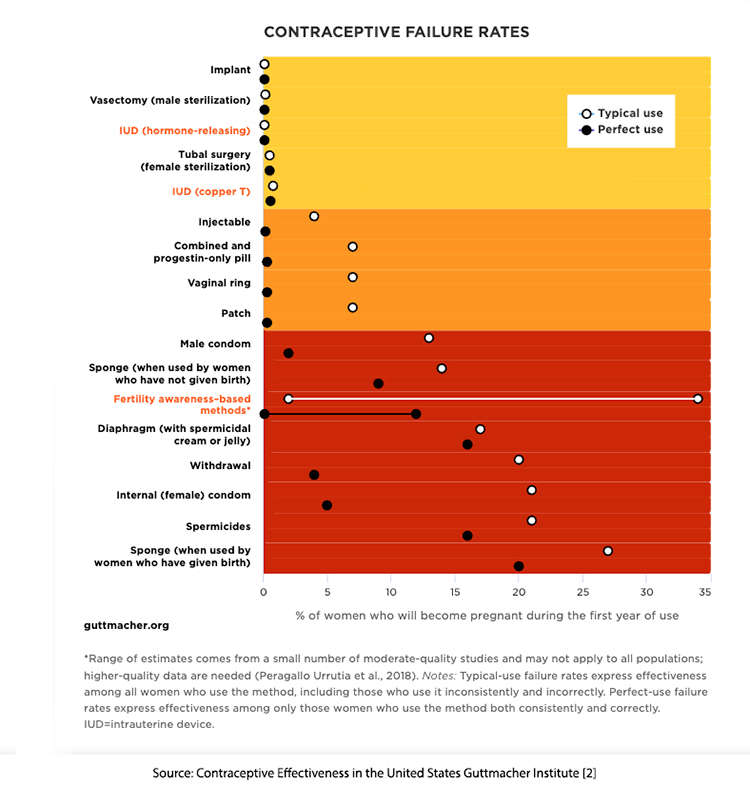While much ink has been spilled, and effort expended, discussing the downstream impacts of the Dobbs decision, little is known about its upstreaming impacts. Contraception, amidst the legal hullabaloo, a JAMA Health Forum report sheds a bit of light on the issue.
The dataset comes from TrinetX, a data aggregating “broker,” providing data from electronic health records (EHRs)" and a multitude of other sources for public and private research, in this instance, “largely from academic medical centers and affiliated clinics in all 4 US census regions. Monthly counts of vasectomies and tubal ligations were used to calculate rates per 100,000 individuals aged 18 to 30. [1]

- As can be plainly seen, in part because of how the image is scaled, there was an uptick in permanent birth control after Dobbs.
- Before Dobbs, permanent contraception was increasing at an annual rate of 2.84/100,000 for women and 1.03/100,000 for men. Post Dobbs, the rate doubled for women to 5.31/100,000, while for men, a momentary surge was followed by essentially a return to the same rate of increase (1.18/100,000).
- The differential between men and women only reinforces the commonly held belief and action that contraception remains a woman’s “responsibility.”
Barrier methods for women and men work well when used properly, but that is an aspirational goal for many. Here is the success rate of birth control by method.

Male contraceptive methods are limited to the not-so-reliable condom, fertility awareness methods, and vasectomy. [3] Vasectomy is by most measures less invasive than tubal ligation, and cost and access difficulties between the two procedures would probably favor more vasectomies. Why, then, so few?
Vasectomies have their own history. Fun fact – prior to 2001, vasectomies were illegal in France because of Napoleonic law prohibiting “self-mutilation.” A Google search will show several studies pointing to myths and cultural barriers to males pursuing vasectomy. However, interestingly enough, the cultural barriers are in Africa, not in WEIRD (Western, Educated, Industrialized, Rich, and Democratic) countries. As the Lancet reports,
“…vasectomy is widely chosen in regions and countries with high socioeconomic development and gender equality.”
In the US, among the young eligible males, the overall vasectomy rate is about 11%, half of Canada’s 22%, or even New Zealand’s 23%. There is also a significant incidence of “regret,” prompting about a 6% rate of attempted reversal consistent with regret among women undergoing tubal ligation.
Why is there no male birth control pill? The development of a male birth control pill has been hampered by treatments that, while effective, have significant hormonal side effects and reductions in libido. Hormonal birth control in women only affects 1 or 2 eggs a month, while male hormonal therapy must address millions of sperm per ejaculation. A recent study reported in PNAS offers an alternative path.
From stem cells to sperm
The testis produces countless sperm stem cells, which, when signaled by Vitamin A (retinoic acid), morph into mature sperm – spermatogenesis. The pulses of Vitamin A bind to a protein, SMRT, which helps coordinate the activation of the genes necessary for spermatogenesis through histone deacetylase inhibitors (HDAC).[4]
Prior efforts to block Vitamin A have been hampered by its crucial role in other organs, creating side effects. A more promising version, a compound named YCT-529, selectively blocks one of the three retinoic acid receptors and, in a pre-clinical study in mice, was 99% effective in preventing pregnancy and was readily reversed over the course of six weeks. A Phase I trial designed to understand dosing, toxicity, and human side effects has just begun.
PNAS reports on another approach that blocks the activity of the SMRT-HDAC complex, which, again, in mice, was a very effective means of reversibly stopping spermatogenesis.
Of course, while both of these are promising medical approaches, they will require men to not only use but be fullycompliant with these medications. The differences in medical compliance based on gender are, for the most part, inconsistent. Still, the data on vasectomy vs. tubal ligation strongly suggests that birth control remains a woman’s task.
[1] As with all studies, there are some limitations. In this instance, the de-identified data prevented analysis by state, organization, or “the differential experiences of Black, Indigenous, Hispanic, disabled, immigrant, and low-income women.” It is interesting to note a carve-out for low-income women, not men, when there was no income data for either group.
[3] As an aside, I am reminded of the old joke about what you call people using the rhythm method (fertility awareness) – parents.
[4] Histones are the protein wrappers of our DNA, forming the structure called chromatin. Tightly packed chromatin is associated with gene repression loosely packed chromatin with activation. Histone acetylation, adding an acetyl group to the histone, leads to gene activation; removing acetyl groups, deacetylation represses genes.
Source: Changes in Permanent Contraception Procedures Among Young Adults Following the Dobbs Decision JAMA Health Forum DOI: 10.1001/jamahealthforum.2024.0424

